TRUE LIES (1994)
A secret agent has his life turned upside down when he discovers his wife might be having an affair with a used-car salesman while terrorists smuggle nuclear war heads into the US.
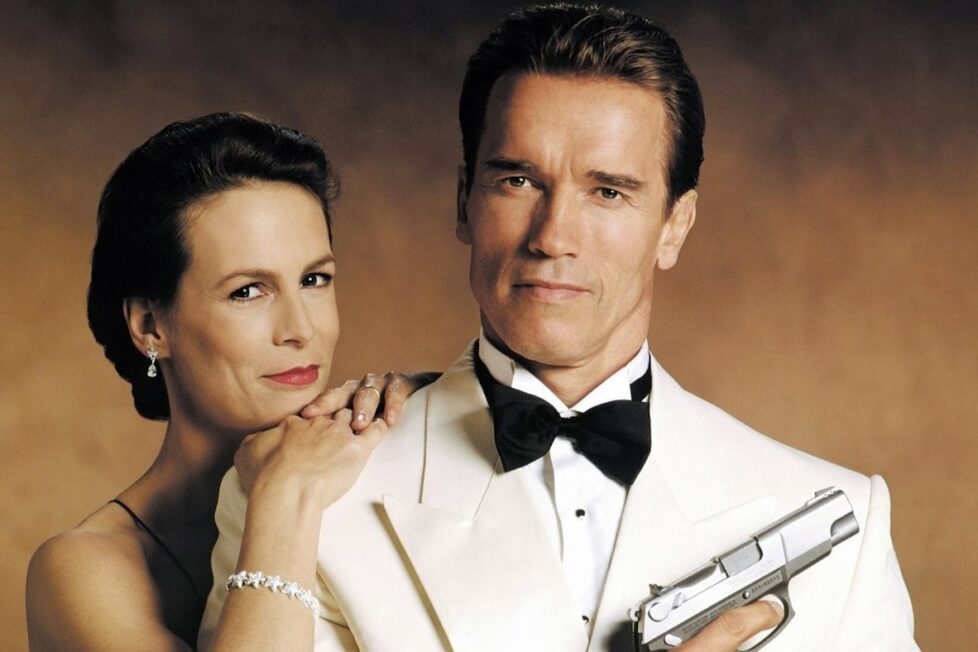
A secret agent has his life turned upside down when he discovers his wife might be having an affair with a used-car salesman while terrorists smuggle nuclear war heads into the US.


Still licking his wounds after the dismal failure of Last Action Hero (1993), Arnold Schwarzenegger returned to the bosom of the man who launched him into the big time with The Terminator (1984) a decade before: James Cameron. It’s often said that major Hollywood directors want to make a James Bond movie, but the franchise typically favours Englishmen, so True Lies felt like Cameron’s own stealth entry into that legendary spy franchise. And with 007 taking a break between the Timothy Dalton and Pierce Brosnan eras, 1990s audiences were starved of espionage thrills designed for a post-Cold War landscape…
Based on the French comedy La Totale! (1991), True Lies has an irresistible premise. Dull computer salesman Harry Tasker (Schwarzenegger) is married to his mousey wife Helen (Jamie Lee Curtis), bringing up their prickly teen Dana (Eliza Dushku), but their boring suburban life together is a lie. Harry is secretly the top agent for counterterrorism agency Omega Sector, and his family is blissfully unaware his days typically involve sneaking into Swiss parties hosted by billionaires, and suchlike, aided by teammates Albert “Gib” Gibson (Tom Arnold) and Faisil (Grant Heslov).
The plot thickens when Harry realises his wife’s seeing a mystery man called Simon (Bill Paxton), who ironically claims to be a government spy but is truthfully a sleazy used-car salesman who tricks bored housewives into bed. Simultaneously, Harry must thwart a terrorist faction led by Salim Abu Aziz (Art Malik), who wants to smuggle MIRV nuclear warheads into the US, while trying to save his marriage.
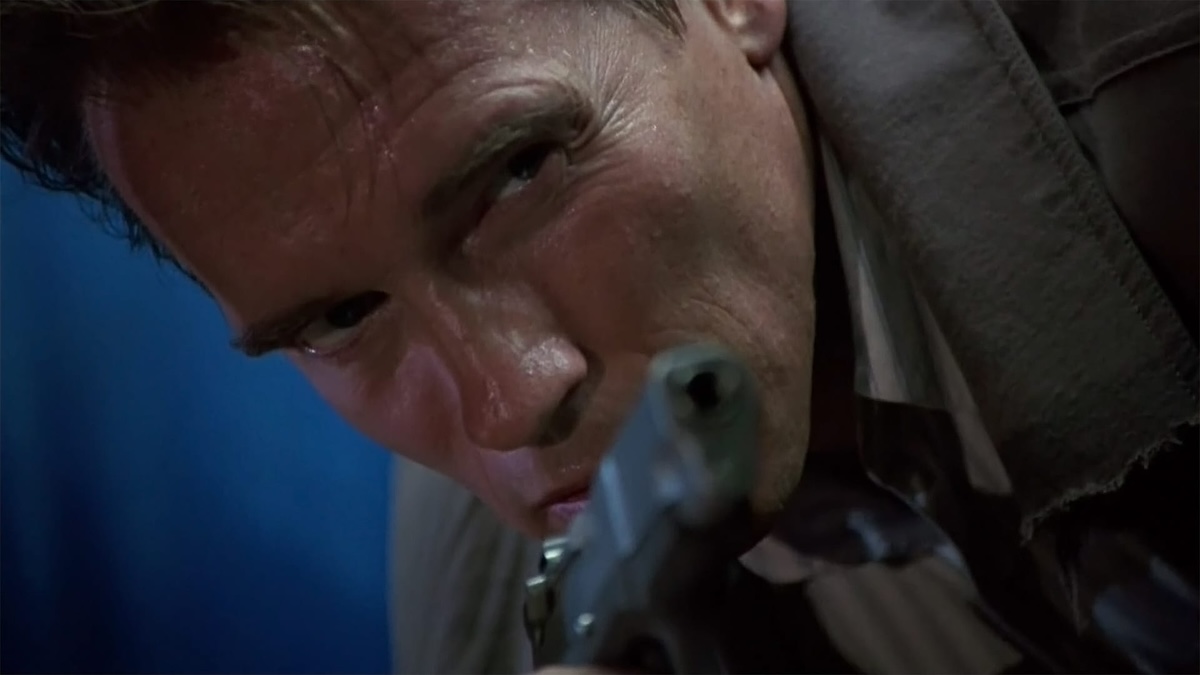
True Lies’ elevator pitch is “What if James Bond had a normal family he had to keep in the dark about his job?”, but with the added flourish of casting Hollywood’s biggest action hero in a film written and directed by the brains behind Aliens (1986) and Terminator 2: Judgment Day (1991). Audiences hadn’t seen what Cameron could do with a more grounded story that had to balance comedy with his knack for action. Without distinct sci-fi worlds and gruesome monsters to fall back on, True Lies had to work because of the interplay between its characters and a more playful tone.
Naturally, this being a James Cameron movie, True Lies wound up being the most expensive movie ever made, at the time, with an estimated production budget of $100–120M. It was also the proving ground for Cameron’s fledgling VFX company Digital Domain. The effects may look relatively humdrum today, but the sequences where an AV-8B Harrier fighter jet hovers around a Miami skyscraper was an astonishing feat at the time for digitally erasing so many wires from a vast number of model shots.
What’s most notable about True Lies today is some of its questionable politics, most notably in the Middle Eastern terrorists being incredibly two-dimensional, as Hollywood had steered away from Russians as go-to villains. The recent Gulf War had made anyone from that region easier to vilify on screen as lunatics, and only the sobering September 11th attacks in 2001 made screenwriters inject a dose of added realism into how they were represented because audiences now felt closer to the idea that Islamic terrorists would want to destroy major US cities. True Lies’ threat was pure fantasy in ’94, but felt worrying likely less than 10 years later.
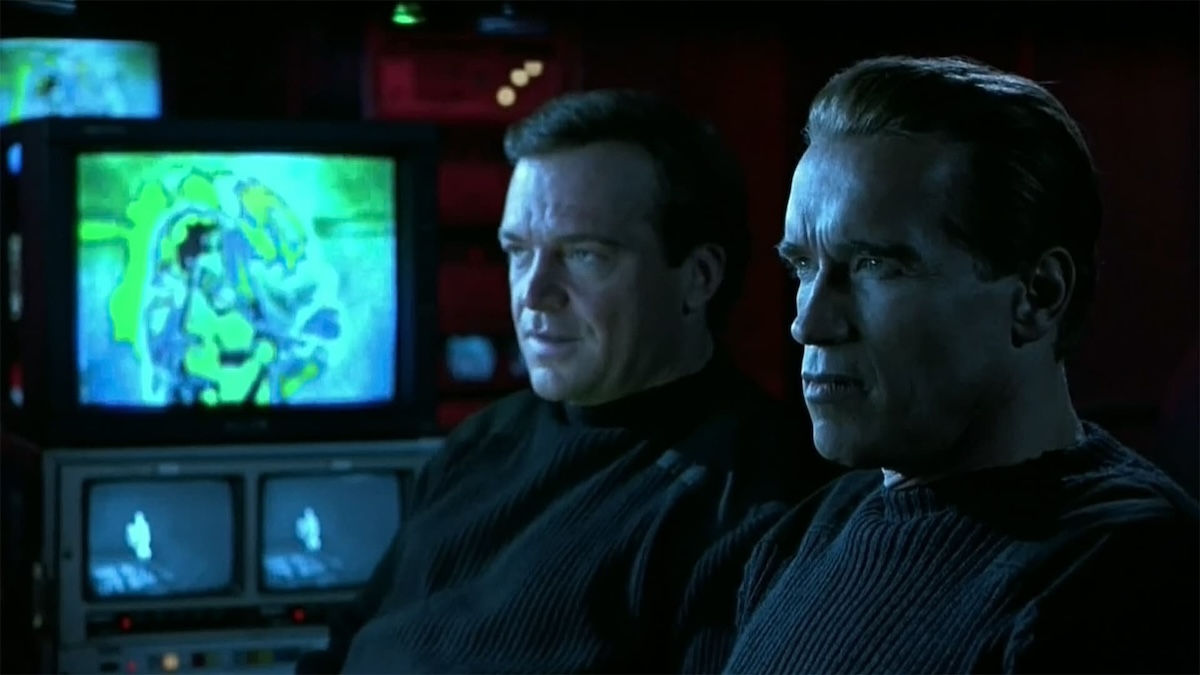
Some of the sexual politics haven’t dated well either. Once Harry discovers his wife’s started to see another man, he’s understandably upset about the situation but proceeds to misuse his agency’s assets to kidnap Helen and interrogate her about the state of their marriage and love life! It felt queasier than I remember it feeling in 1994.
The ensuing subplot where Helen is assigned a fake mission to go undercover as a prostitute and dance, semi-naked, in front of an oil tycoon (actually Harry), also plays differently now. Harry comes across as insensitive and manipulative, considering all his wife’s done is fallen for a scam when he’s outright lied to her and their daughter about himself for 15 years. And while the movie doesn’t show this, it’s a little hard to believe Harry hasn’t been in some compromising situations with glamorous women over the years—beyond having to dance a risque tango with Tia Carrere.
The story and performances are decent and arguably a high point for Schwarzenegger, but True Lies is mostly notable for its action and stunts. Most of them aren’t extraordinary to modern eyes, but they hold up incredibly well and were very influential. Harry on horseback chasing Aziz on a motorcycle through the city, brings to mind a similar sequence in John Wick: Chapter 3 (2019), only Keanu Reeves was up against multiple bikers armed with swords. A brawl inside a bright restroom also feels like a precursor to a similar set piece in Mission: Impossible —Fallout (2018). And while the versions in those later movies are ostensibly “better” for being more ambitious, True Lies benefits from knowing little was tweaked by VFX in post-production.
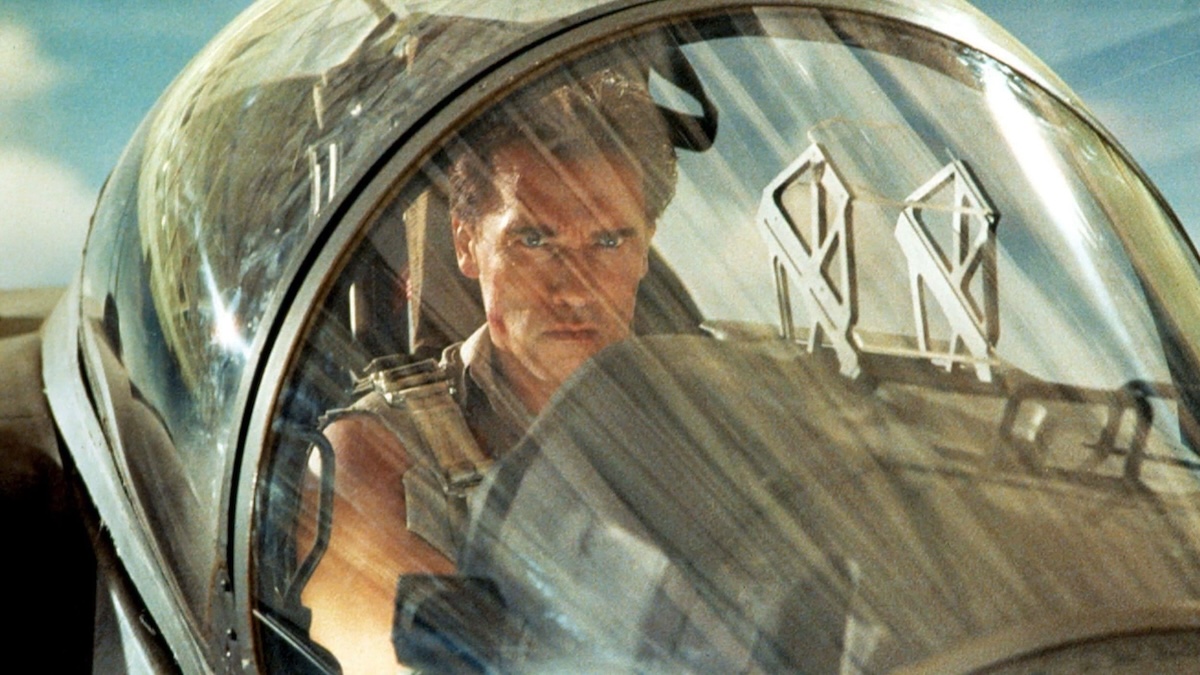
A climactic sequence with a bridge in the Florida Keys being destroyed by two missiles (evoking an MI:III stunt, come to think of it), also looks incredible all these years later. It looks like they did it for real (despite actually using miniatures) and it’s topped by a real stunt involving Helen dangling from a helicopter as she’s pulled to safety from a car about to fall into the half-destroyed bridge gap.
Modern action films have astonishing moments and 21st-century VFX is becoming unnoticeable at times, but audiences sense a lot is performed around a greenscreen or with digital effects—maybe because shooting on location is more expensive and time-consuming than ever before. Or maybe it’s all down to perception (knowing CGI wasn’t commonplace in 1994), as True Lies was made in that transitionary period when Hollywood still relied on practical effects and old-fashioned stunts, but there was enough technical wizardry available to sweeten the finished product without smothering it under too much artificiality.
Schwarzenegger’s career floundered after True Lies, as no movie he made since came close to eclipsing the period of success he enjoyed in the 10 years bookended by two of Cameron’s blockbusters, The Terminator and True Lies. Action stars were becoming less cartoonish-looking than Schwarzenegger and Sylvester Stallone’s brand of muscular heroes in the 1980s, thanks to Bruce Willis in Die Hard (1988) and Keanu Reeves in Speed (1994), so personality and realism started to matter more than the size of your biceps. Audiences themselves started to respond more to compelling concepts, established intellectual property, and enormous spectacles over which actor’s name was most prominent on the poster.
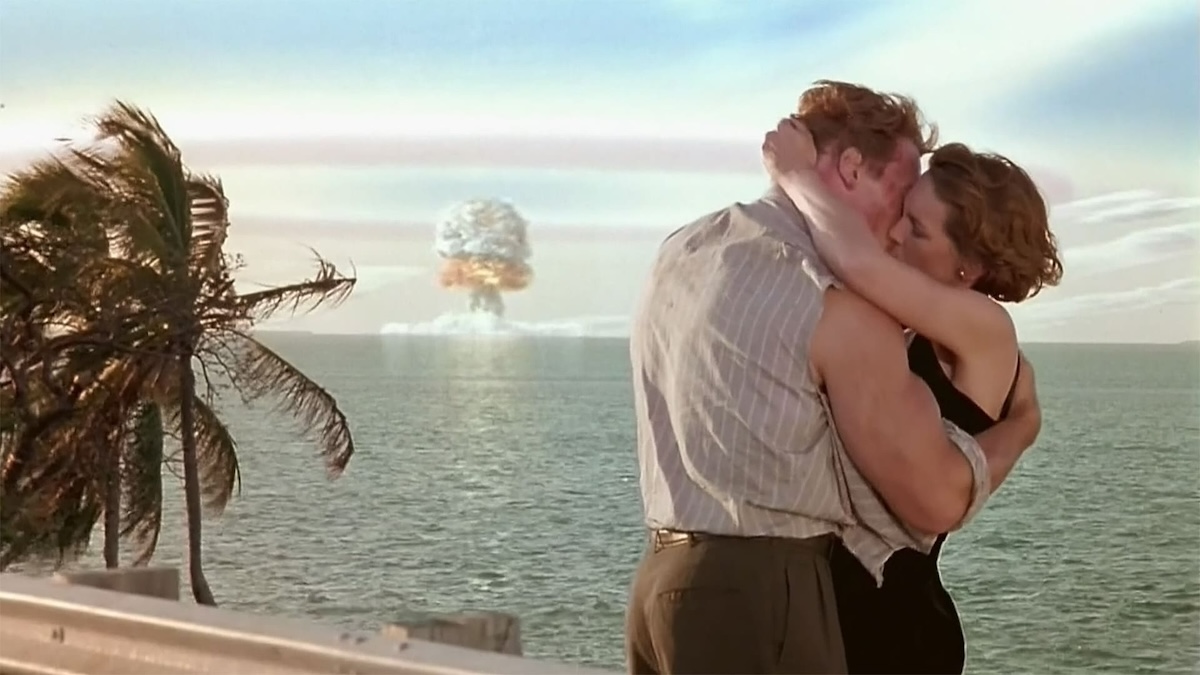
Cameron himself must have realised this change in audience appetite because his next film, Academy Award-winning behemoth Titanic (1997), also gave him opportunities to put incredible imagery on screen, but was primarily a grounded love story that worked because of the chemistry between two actors. And after a long break, he seems to have gone down a similar path to George Lucas in only wanting to make CGI-heavy blockbusters that can be created inside a studio with no bothersome location shooting, through his ongoing Avatar saga.
Overall, True Lies feels like a relic of a bygone age and its casting works against the conceit of the film — who believes musclebound Schwarzenegger as a workaholic computer salesman, or Jamie Lee Curtis as a demure housewife? But it’s so effectively staged and contains a lot of memorable set-pieces and ridiculous moments, kept alive with enjoyable performances and excellent support from Tom Arnold and Bill Paxton as comic relief. And while we’ve seen better spins on this type of material since—like Mr and Mrs Smith (2005) —it’s hard not to be charmed by a movie that aims to entertain and embrace its ridiculousness.
USA | 1994 | 141 MINUTES | 2.39:1 | COLOUR | ENGLISH • FRENCH • ARABIC • GERMAN

James Cameron’s True Lies arrives amidst a lot of controversy from home theatre enthusiasts, as the director has a bad reputation for overseeing restorations of his movies that try to make them feel like they were made today.
This usually means a great deal of DNR (digital noise reduction) is employed to eliminate film grain, as movies were almost entirely shot on 35mm during his ’80s and ’90s period. Other automated video processes added to the scans can be divisive. The 4K release of Terminator 2 was particularly unfortunate thanks to how it made the skin of actors look “waxy”, and True Lies falls victim to that as well. Although I didn’t find it as off-putting as some. And at least the colouring doesn’t look as different as the T2 4K disc did, which was an equally bad flaw.
True Lies had its original camera negatives scanned to create a 4K Digital Intermediate, which was then “optimised” by proprietary software created by Park Road —meaning photochemical grain was reduced and finer details enhanced using an algorithm.
What does this mean? Well, when you compare screenshots of the old True Lies DVD, or later HD version that’s been available to stream, with the same shot from this 4K disc… you do occasionally find egregious moments when it looks like the actors have a Snapchat filter over their faces. There’s an unnaturally smooth look and loss of wrinkles and skin pores. But when watching the film, with everything in motion, it didn’t bother me as much. There are moments when you catch sight of actors looking a bit cartoonish, but it’s sporadic. And when you’re enjoying the film and not overanalysing every frame, I wasn’t taken out of the film by how jarring it looks. I haven’t seen the film since it was on VHS, admittedly, so it looks comparatively amazing —especially shots without people, as it’s easier spotting uncanniness in human faces.

director: James Cameron.
writer: James Cameron (based on the film ‘La Totale!’ by Claude Zidi, Simon Michaël & Didier Kaminka.)
starring: Arnold Schwarzenegger, Jamie Lee Curtis, Tom Arnold, Bill Paxton, Art Malik & Tia Carrere.
